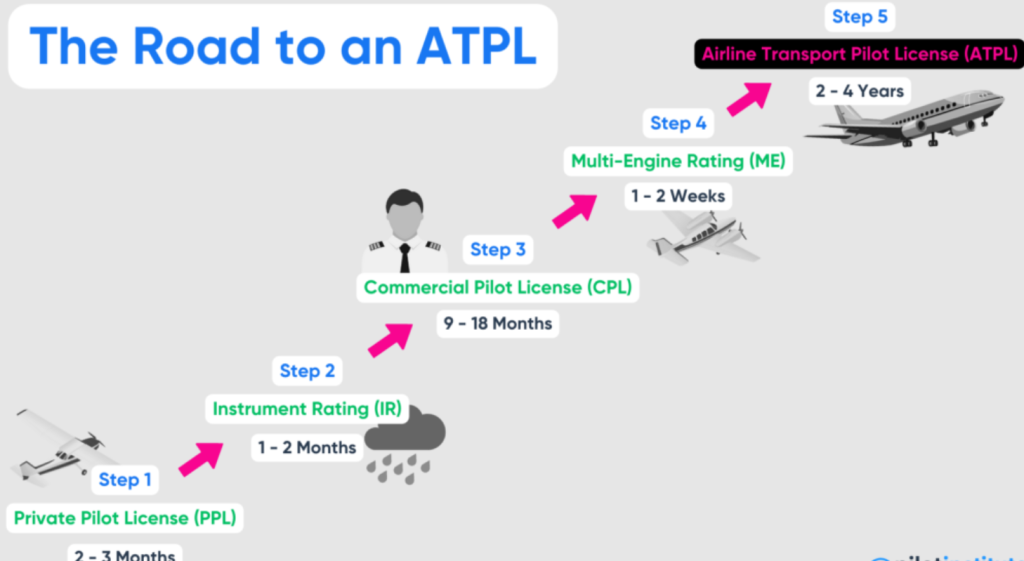
An Airline Transport Pilot License (ATPL) is the highest level of pilot license that allows pilots to fly commercial aircraft. It is required for pilots who want to fly for airlines or other commercial operators.
To obtain an ATPL, pilots must meet certain requirements, including:
- Be at least 21 years old
- Hold a valid Commercial Pilot License (CPL)
- Complete a minimum of 1,500 hours of flight time, including 500 hours as pilot in command
- Pass a written exam and a practical flight test
In addition to the above requirements, pilots must also meet certain medical standards. Pilots must have a valid Class 1 medical certificate, which is the highest level of medical certification for pilots.
The cost of obtaining an ATPL varies depending on the flight school and the location. In general, it costs between $100,000 and $200,000 to obtain an ATPL.
With an ATPL, pilots can fly for commercial airlines, cargo airlines, or even air ambulance services. They can also fly for non-profit organizations, such as search and rescue teams.
Here are some of the benefits of having an ATPL:
- The ability to fly for commercial airlines
- The ability to fly larger and more complex aircraft
- The ability to work as a pilot for a major airline
- The ability to earn a high salary as a pilot
If you are interested in becoming an airline pilot, there are a few things you can do to get started:
- Do your research and find a reputable flight school.
- Talk to other pilots and get their advice.
- Start saving money for flight training.
- Get in good physical condition.
Becoming an airline pilot is a challenging but rewarding career. If you are passionate about flying, an ATPL can be the first step to a fulfilling career in aviation.

Here are some of the differences between a CPL and an ATPL:
- An ATPL allows pilots to fly for commercial purposes, while a CPL does not.
- An ATPL requires more flight time than a CPL.
- An ATPL requires a higher level of medical certification than a CPL.
- An ATPL is more expensive to obtain than a CPL.
If you are interested in a career as a pilot, it is important to understand the difference between a CPL and an ATPL. If you want to fly for a commercial airline, you will need to obtain an ATPL.
An Airline Transport Pilot License (ATPL) is the highest level of pilot certification and qualification available, allowing individuals to act as the captain or first officer (co-pilot) of large commercial aircraft, including passenger and cargo planes. The ATPL is a prestigious and rigorous license that signifies a pilot’s expertise, experience, and competency to operate complex and large aircraft safely. Here are key points about the Airline Transport Pilot License (ATPL):
- Eligibility: To be eligible for an ATPL, candidates typically need to meet strict requirements, which can vary by country and aviation authority. Common eligibility criteria include:
- Being at least 21 years old.
- Holding a Commercial Pilot License (CPL) or its equivalent.
- Accumulating a substantial number of total flight hours, often in the range of 1,500 to 1,500 hours of flight time, including specific experience requirements.
- Successfully passing theoretical knowledge exams.
- Training: ATPL candidates undergo comprehensive training, including both ground school instruction and flight training. The training covers advanced flight operations, navigation, aerodynamics, aircraft systems, emergency procedures, and more.
- Flight Hours: ATPL candidates must accumulate a significant number of total flight hours, including specific experience requirements in various categories of aircraft (e.g., single-engine, multi-engine, turbine, etc.). The total flight hour requirement is considerably higher than that for a CPL.
- Theory Examinations: Candidates are required to pass a series of rigorous written examinations that assess their knowledge of advanced aviation subjects, such as advanced aerodynamics, aircraft performance, airline operations, and safety procedures.
- Airline Transport Pilot Certificate: Upon completing the necessary training, flight hours, and exams, candidates receive an Airline Transport Pilot Certificate, granting them the authority to serve as the captain or co-pilot of large commercial aircraft.
- Command of Large Aircraft: Holders of an ATPL are qualified to operate as captains or co-pilots on commercial airliners, including aircraft such as Boeing 737s, Airbus A320s, and other large jetliners.
- Career Advancement: The ATPL is often a prerequisite for command positions at airlines and major aviation operators. Airline captains, also known as line captains, are typically required to hold an ATPL.
- Continuing Education and Evaluation: ATPL holders must maintain their medical fitness and participate in recurrent training to stay current with industry standards and regulations. They are subject to regular checks and evaluations to ensure their continued competence.
The ATPL represents the pinnacle of a pilot’s career and is associated with a high level of responsibility, as ATPL holders are responsible for the safe operation of commercial flights, crew management, and decision-making during various phases of flight. It is a significant achievement and is a testament to a pilot’s dedication to safety and professionalism in aviation.
